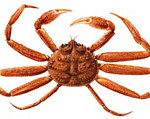
Strongylocentrotus nudus and S. intermedius
Sea urchins are often used as indicator organisms in public aquaria to determine whether the system is functioning properly. These organisms are extremely sensitive to water conditions and are first to show signs of stress, seen when their spines are laid down or are shed.
Warning! Some sea urchins are covered with sharp venom-filled spines that can easily penetrate and break off into the skin – even through a wetsuit. The DAN (Divers Alert Network) website contains useful information on how to handle the unfortunate effects of accidental brushes with these and other poisonous marine organisms. Check out http://www.diversalertnetwork.org/ for any information that you need.
Sea urchins (echinoderms) are a group of marine invertebrates that can be found in almost every major marine habitat from the poles to the equator and from the intertidal zone to depths of more than 5,000 metres. There are around 800 extant species and the group has a long and detailed fossil record stretching back many millions of years.
All echinoderms have tube-feet and these play a very important role in feeding and respiration. Echinoids move by means of spines and climb and cling on to hard substrata by means of their tube-feet. The spines also offer the primary means of defence. Sea urchins are principally herbivores and feed in a variety of ways. They have a powerful internal jaw and graze on algae or sedentary organisms, thanks to a complex system of teeth called the “lantern of Aristotle”, first described by the Greek philosopher himself, over 2000 years ago. The sturdy skeleton of the urchin is called a test. Intensive grazing by strongylocentrotid sea urchins sometimes causes drastic decreases of seaweed and subsequent maintenance of barren grounds. In northern Japan for example, the long-spined purple species,
Strongylocentrotus nudus has been dominant on barren grounds along the Sea-of-Japan coast as well as the Pacific Coast. Prolonged barrens cause serious social problems. In these barren grounds, gradual elevation of sea water temperature, deficiency of nutrients and/or antifouling of encrusting coralline algae have been considered factors preventing recovery of seaweed beds. Recently, however, it was strongly suggested that intensive grazing by S. nudus is the major factor that keeps the region barren, based on detailed observations of barren bottoms, transplantation of kelp, removal of sea urchins and aquarium experiments in which corallines and herbivores coexist. Although the factors that initiated intensive grazing by the sea urchin have not been specified yet, two possibilities are the enlarged harvest of kelp, and the decrease of solid organic matter, which caused a shortage of food for sea urchins or other animals and nutrients for kelp growth.
Strongylocentrotus intermedius is distributed along the Asian and Siberian coast of the Pacific. It is found on shallow rocky bottoms and is associated with kelp. The growth rate varies depending on species density and the level of available nutrition. In high growth conditions, individual specimens will reach 40 mm test diameter in 2 to 4 years and maximum sizes of over 55 mm at maximum ages of 6 to 10 years. Sexual maturity occurs at around 30 to 35 mm test diameter (2 years of age) and spawning occurs in spring and autumn.
Strongylocentrotus nudus occurs on the Pacific coast on north Asia and Siberia. It is found in the intertidal to subtidal rocky reefs and is also strongly associated with kelp communities. Overgrazing by S. nudus promotes the formation of coralline flats. Growth varies depending on nutrition. In kelp forests individuals reach 50 mm test diameter in 2 to 4 years, whilst this will take individuals 7 to 8 years on the nutrient deficient coralline flats. Maximum longevity is reported as 14 to 15 years. Sexual maturity is attained at 40 to 45 mm test diameter, and spawning takes place in autumn.








Social Profiles